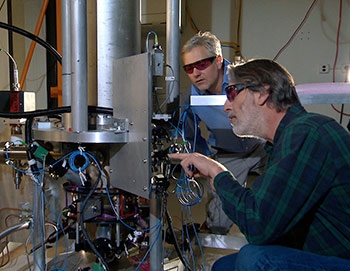Tag Archives: atomic clock
NASA Explains Why June 30 Gets an Extra Second
Scientist Create New Most Accurate Atomic Clock
Scientists Create Clock that Won’t Lose or Gain a Second for 15 Billion Years
When it comes to accuracy in telling time, the atomic clock is at the top of the heap. In fact, an atomic clock is used right now to set the Coordinated Universal Time (UTC), which is the official world time. That current clock is incredibly accurate and measures the vibration frequency of Caesium 133 and is accurate to within a second over 100 million years.
A team of scientists from National Institute of Standards and Technology and the University of Colorado in Boulder have created a new type of atomic clock that makes the clock currently considered the gold standard for timekeeping look highly inaccurate. The new clock is an optical lattice clock that uses strontium atoms to tell time and is accurate enough to not gain or lose a second in 15 billion years.
Not bad, given the fact that astrophysicists estimate that the universe is only about 13.8 billion years old. The new clock is now the world’s most accurate. The researchers hope that it will one day become the gold standard for measuring time.
[via The Guardian]
The Atomic Clock: A Clock For Generations

Winding watches can get tiresome, and most users would rather do that as little as possible. So, how does doing it once every 300 million years sound like?
There’s a new guideline for time all across the world thanks to one of the most precise devices in existence, the NIST-F2 atomic clock, created by the NIST (National Institute of Standards and Technology). This device is meant to provide the time for all U.S.civilian devices as well as frequency with unprecedented exactitude.
This device is meant to replace the F1, a former atomic device. and is meant to run for 300 million years. The NIST-F2 is three times more precise and will replace the previous standard dating since 1999. NIST will keep running the F1 and F2 clocks simultaneously for comparison’s sake. Furthermore, the F2 will be providing timing and synchronization measurement services for plenty of official uses such as time-stamping U.S. bills, and sync clocks in computers and cellphones around the world.
Source: PC Mag
Be social! Follow Walyou on Facebook and Twitter, and read more related stories about the Kindle solar charger that makes travelers forget about wires and the HP Chromebook 11 that charges over microUSB.
Cesium 133 Atomic Wristwatch Is Huge and Accurate
Laser-powered atomic clock fuels temporal pedants’ ire
If you thought that your regular atomic clock, which loses a second once every few years, is adequate for your needs, then Dr. Jerome Lodewyck wants a word. His team at the Paris Observatory claims to have invented an atomic clock which only loses a second every three centuries. Rather than measuring the oscillations of caesium atoms, the "Optical Lattice Clock" uses a laser to excite strontium atoms which vibrate much faster and are, therefore, more accurate. Of course, it's a cruel irony that just as soon as someone's plonked down $78,000 on a Hoptroff No. 10, a rogue gang of scientists find a way to make it obsolete.
Filed under: Alt
Via: BBC News
Source: Nature
Laser-powered atomic clock fuels temporal pedants’ ire
If you thought that your regular atomic clock, which loses a second once every few years, is adequate for your needs, then Dr. Jerome Lodewyck wants a word. His team at the Paris Observatory claims to have invented an atomic clock which only loses a second every three centuries. Rather than measuring the oscillations of caesium atoms, the "Optical Lattice Clock" uses a laser to excite strontium atoms which vibrate much faster and are, therefore, more accurate. Of course, it's a cruel irony that just as soon as someone's plonked down $78,000 on a Hoptroff No. 10, a rogue gang of scientists find a way to make it obsolete.
Filed under: Alt
Via: BBC News
Source: Nature
Rubicon Atomic Preamp With Integrated Atomic Clock
![]()
Antelope Audio’s Rubicon Atomic Preamp is designed for high-end consumer electronics enthusiasts. It is known as the world’s first 384kHz converter, phono stage preamp and headphone amplifier with a Rubidium atomic clock. This integrated atomic clock is claimed to be 100,000 times more stable than a traditional crystal oscillator. The Rubicon Atomic Preamp also adopts Antelope’s 64-bit Accoustically Focused Clocking technology, which improves the sound quality. Additional features include 384kHz USB streaming, DLNA capability, dual S/PDIF de-jittered outputs and dual stage headphone amps. [Antelope Audio]





